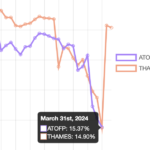It was a fine on a bank that no longer exists, in punishment for wrong-doing committed more than two years ago, by a business that was subsequently shut down by the bank concerned. But as we highlighted here more than two years ago, the Archegos scandal did not only involve Credit Suisse. At least five other banks were connected to the family office founded by Bill Hwang, which accumulated some $50 billion of equity exposure that was unwound in a fire sale in March 2021.
In the chaos of that fire sale, Credit Suisse lost $5.1 billion, Nomura lost $2.9 billion, Morgan Stanley $900 million and UBS $800 million as a result of their trades with Archegos. Deutsche Bank, Wells Fargo and Goldman Sachs also traded with Archegos but did not report losses.
So far, only Credit Suisse has been sanctioned by regulators, although in 2021 the Federal Reserve and UK Prudential Regulatory Authority fired shots across the bows of the other banks in the form of ‘Dear CEO’ letters. Subsequently, Morgan Stanley and Goldman won the dismissal of a shareholder lawsuit that accused them of Archegos-related market manipulation.
So, should we all now move on? What hasn’t changed is the size of equity financing exposures at the banks, and their importance for bank revenues.
To appreciate the scale, we look once again at regulatory filings, such as Basel Pillar 3 and US FR Y-9C disclosures. The European version of Pillar 3 contains a table called CCR5, which includes gross securities financing exposure, and more importantly a breakdown of SFT collateral by asset type. The equity portion of this table ought to match the equities financing exposure (allowing for overcollateralization).
|
Data source: FRY-9C filings |
 Levelling the Playing Field
Levelling the Playing Field
 Barclays and Labour's growth plan
Barclays and Labour's growth plan
 Plummeting bonds reflect souring UK mood for outsourcing and privatisation
Plummeting bonds reflect souring UK mood for outsourcing and privatisation
 Dimon rolls trading dice with excess capital
Dimon rolls trading dice with excess capital